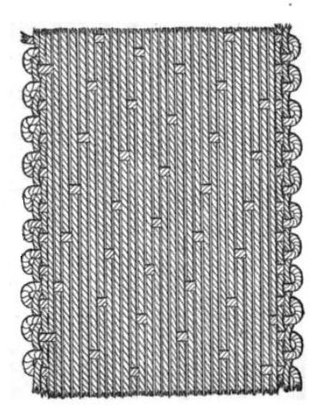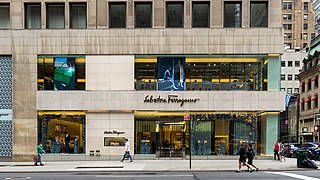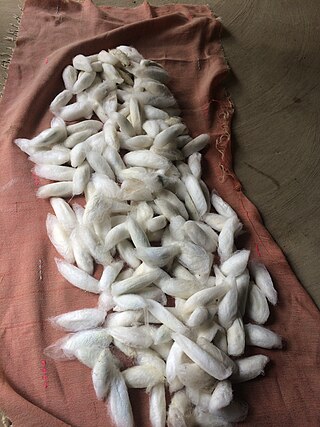
Wool is the textile fiber obtained from sheep and other mammals, especially goats, rabbits, and camelids. The term may also refer to inorganic materials, such as mineral wool and glass wool, that have some properties similar to animal wool.

Textile is an umbrella term that includes various fiber-based materials, including fibers, yarns, filaments, threads, different fabric types, etc. At first, the word "textiles" only referred to woven fabrics. However, weaving is not the only manufacturing method, and many other methods were later developed to form textile structures based on their intended use. Knitting and non-woven are other popular types of fabric manufacturing. In the contemporary world, textiles satisfy the material needs for versatile applications, from simple daily clothing to bulletproof jackets, spacesuits, and doctor's gowns.

Yarn is a long continuous length of interlocked fibres, used in sewing, crocheting, knitting, weaving, embroidery, ropemaking, and the production of textiles. Thread is a type of yarn intended for sewing by hand or machine. Modern manufactured sewing threads may be finished with wax or other lubricants to withstand the stresses involved in sewing. Embroidery threads are yarns specifically designed for needlework. Yarn can be made of a number of natural or synthetic materials, and comes in a variety of colors and thicknesses. Although yarn may be dyed different colours, most yarns are solid coloured with a uniform hue.

A satin weave is a type of fabric weave that produces a characteristically glossy, smooth or lustrous material, typically with a glossy top surface and a dull back; it is not durable, as it tends to snag. It is one of three fundamental types of textile weaves alongside plain weave and twill weave.
Ikat is a dyeing technique from Southeast Asia used to pattern textiles that employs resist dyeing on the yarns prior to dyeing and weaving the fabric. In Southeast Asia, where it is the most widespread, ikat weaving traditions can be divided into two general groups of related traditions. The first is found among Daic-speaking peoples. The second, larger group is found among the Austronesian peoples and spread via the Austronesian expansion to as far as Madagascar. It is most prominently associated with the textile traditions of Indonesia in modern times, from where the term ikat originates. Similar unrelated dyeing and weaving techniques that developed independently are also present in other regions of the world, including India, Central Asia, Japan, Africa, and the Americas.
Ermenegildo Zegna N.V., also known as Zegna Group or the Ermenegildo Zegna Group, is an Italian luxury fashion house headquartered in Milan. It was founded in 1910 by Ermenegildo Zegna in Trivero, Biella, in the Piedmont region of northern Italy. It is led by the Zegna family and is one of the most renowned Italian men’s clothing businesses internationally. As of 2021, it is a public company that is listed on the New York Stock Exchange.

Taffeta is a crisp, smooth, plain woven fabric made from silk, nylon, cuprammonium rayons, acetate, or polyester. The word came into Middle English via Old French and Old Italian, which borrowed the Persian word tāfta (تافته), which means "silk" or "linen cloth". As clothing, it is used in ball gowns, wedding dresses, and corsets, and in interior decoration, for curtains or wallcovering. It tends to yield a stiff cloth with a starched appearance that holds its shape better than many other fabrics and does not sag or drape.
Loro Piana S.p.A. is an Italian luxury fashion brand specialized in textile manufacturing and ready-to-wear clothing headquartered in Milan, Italy. Since its start as a merchant of cashmere, vicuña, linen and merino fabrics, Loro Piana expanded to design knitwear, leather goods, footwear, fragrance and related accessories. The company has three divisions: textiles, high fashion and luxury goods. Its core branding includes the Loro Piana family signature and coat-of-arms, depicting a European beech tree, a golden eagle, and two diagonal Stars of Italy, framed by flower thistles.

Cloth of gold or gold cloth is a fabric woven with a gold-wrapped or spun weft—referred to as "a spirally spun gold strip". In most cases, the core yarn is silk, wrapped (filé) with a band or strip of high content gold. In rarer instances, fine linen and wool have been used as the core.
The Marzotto Group is an Italian textile manufacturer, based in Valdagno.

Salvatore Ferragamo S.p.A., doing business as Ferragamo, is an Italian luxury fashion house focused on apparel, footwear, and accessories headquartered in Florence, Italy. It specializes in designing and manufacturing footwear and leather goods, which together account for over 86% of its revenue. The remaining products include ready-to-wear, silk products, fashion accessories, and licensed eyewear, watches, and perfumes. It operates 447 mono-brand stores worldwide as of September 2022.

Grenadine is a weave characterised by its light, open, gauze-like feel, and is produced on jacquard looms. Originally produced in Italy and worn as a black silk lace in France in the eighteenth century, it is now woven with silk for use in ties.

Eri silk is a type of peace silk produced by the domesticated silkworm Samia ricini. It is primarily produced in the northeastern Indian states of Assam, Nagaland and Meghalaya, but it is also found in Bihar, Odisha, West Bengal and Andhra Pradesh on a smaller scale. It was imported to Thailand in 1974.

The history of Italian fashion is a chronological record of the events and people that impacted and evolved Italian fashion into what it is today. From the Middle Ages, Italian fashion has been popular internationally, with cities in Italy producing textiles like velvet, silk, and wool. During the Middle Ages and Renaissance, Italian fashion for both men and women was extravagant and expensive, but the fashion industry declined during the industrialization of Italy. Many modern Italian fashion brands were founded in the late 19th and early 20th centuries, and in the 1950s and 1960s, Italian fashion regained popularity worldwide. While many clients of Italian fashion designers are celebrities, Italian fashion brands also focus on ready-to-wear clothes.
Piquadro is an Italian leather goods company specializing in business and travel items in Italy and internationally. The company offers products ranging from men's and women's professional bags to luggage and small leather items. As of April 2010, it distributed its products through approximately 1500 points of sale. Piquadro has received a number of patents in recognition of its technical and functional innovations.
Dimensional stability pertains to a fabric's ability to maintain its initial size and shape even after undergoing wear and care, which is a desirable property. Textile manufacturing is based on the conversion of fiber into yarn, yarn into fabric, includes spinning, weaving, or knitting, etc. The fabric passes through many inevitable changes and mechanical forces during this journey. When the products are immersed in water, the water acts as a relaxing medium, and all stresses and strains are relaxed and the fabric tries to come back to its original state.
Scappino is an Italian luxury fashion house created in 1914 by Domenico Scappino in Turin, Italy, specializing in silk products like ready-to-wear ties, shoes, watches, jewellery, accessories, sunglasses, and fragrances.

Dharmavaram handloom pattu sarees and paavadas are textiles woven by hand with mulberry silk and zari. They are made in Dharmavaram of Anantapur district in the Indian state of Andhra Pradesh. It was registered as one of the geographical indication from Andhra Pradesh by Geographical Indications of Goods Act, 1999.

Odisha Ikat, is a kind of ikat known as Bandhakala and Bandha, a resist dyeing technique, originating from Indian state of Odisha. Traditionally known as "Bandhakala"', "Bandha", '"Bandha of Odisha", it is a geographically tagged product of Odisha since 2007. It is made through a process of tie-dyeing the warp and weft threads to create the design on the loom prior to weaving. It is unlike any other ikat woven in the rest of the country because of its design process, which has been called "poetry on the loom". This design is in vogue only at the western and eastern regions of Odisha; similar designs are produced by community groups called the Bhulia, Kostha Asani, and Patara. The fabric gives a striking curvilinear appearance. Saris made out of this fabric feature bands of brocade in the borders and also at the ends, called anchal or pallu. Its forms are purposefully feathered, giving the edges a "hazy and fragile" appearance. There are different kinds of bandha saris made in Odisha, notably Khandua, Sambalpuri, Pasapali, Kataki and Manibandhi.

Stefano Ricci is a private family-owned Italian luxury lifestyle brand with headquarters located in Fiesole, right outside Florence. With 78 monobrand boutiques worldwide, the brand produces menswear and accessories, a line for juniors "SR Junior", homeware "SR HOME" and lifestyle products. The brand also offers bespoke and interior design services for both yachts and residences. Stefano Ricci S.p.A. was rated as EE (average) by the London-based Standard Ethics agency for three consecutive years 2015, 2016, and 2017. The New York Times calls Stefano Ricci "clothier to the 0.001 percent".












